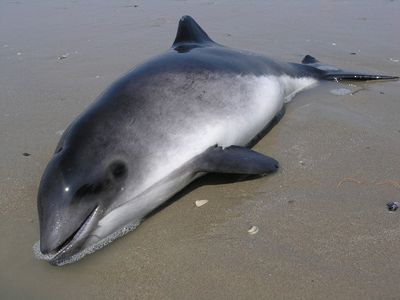Difference between revisions of "Organohalogenated contaminants in harbour porpoises"
m (Pesticides in harbour porpoises moved to Organohalogenated contaminants in harbour porpoises: The article is is not limited to pesticides) |
(→References) |
||
| Line 22: | Line 22: | ||
<references/> | <references/> | ||
| + | |||
| + | |||
| + | {{author | ||
| + | |AuthorID=19826 | ||
| + | |AuthorFullName=Daphnis De Pooter | ||
| + | |AuthorName=Daphnisd}} | ||
[[Category:North Sea]] | [[Category:North Sea]] | ||
[[Category:Coastal and marine pollution]] | [[Category:Coastal and marine pollution]] | ||
Revision as of 10:27, 13 March 2013
Context of the study
The harbour porpoise is a vulnerable species in European waters. During the past decades, the number of observations of this cetacean have decreased. Although observations along the Dutch coast have increased since 1990, this trend is more likely to reflect a shift in the distribution, than an actual increase of the population. [1] One of the main threats to the harbour porpoise is accidental capture by fishing gear. High levels of contaminants, declining fish stocks and other anthropogenic stress factors (wind mills, sonar, shipping,... [2]) are also considered possible threats.[3]
Content of the study
The study evaluated the occurrence of important organic contaminants in the harbour porpoise: one of the top predators in of the North Sea ecosystem. Harbour porpoises don't migrate on a large scale, which makes them a suitable indicator for local pollution. This study specifically evaluated the occurrence of PBDEs, PCBs and organochlorine pesticides. The study was based on liver samples of 21 harbour porpoises, which stranded along the Belgian coast between 1997 and 2000.
Main results of the study
Organoclorine pesticides occurred in low concentrations, while relatively high values of PCBs and PBDEs were measured (PCBs averaged 36,4 µg/g, PBDEs averaged 2,3 µg/g lipid). Comparison with other studies shows that the PCB concentrations are higher in harbour porpoises stranded along the Dutch and Belgian shorelines than in those stranded along the English shoreline. PCB discharges from the Rhine, Scheldt and Meuse rivers might have caused these higher concentrations along the Belgian and Dutch coasts. Concentrations of DDTs (the most important organochlorine pesticide) are lower than those reported in 1991. This reflects the decline of DDT concentrations in the North Sea after the European ban in the 1970's.
Higher median concentrations of all examined contaminants have been found in adults. This is explained by the accumulation of these pollutants in the animals with increasing age. Differences in food preferences between adult and juvenile harbour porpoises might be an additional factor. Adult females showed lower average pollutant concentrations than adult males: during pregnancy females transfer these pollutants (which primary accumulate in body fat) through their milk (which contains 30-60% fat) towards their pups.[3]
References
- ↑ http://www.natuurinformatie.nl/ecomare.devleet/natuurdatabase.nl/i000225.html
- ↑ http://www.zeezoogdieren.alterra.wur.nl/p6c_bruinvis.htm
- ↑ 3.0 3.1 Covaci, A.; Van de Vijver, K.; De Coen, W.; Das, K.; Bouquegneau, J.-M.; Blust, R.; Schepens, P. (2002). Determination of organohalogenated contaminants in liver of harbour porpoises (Phocoena phocoena) stranded on the Belgian North Sea coast. Mar. Pollut. Bull. 44(10): 1157-1169
Please note that others may also have edited the contents of this article.
|
